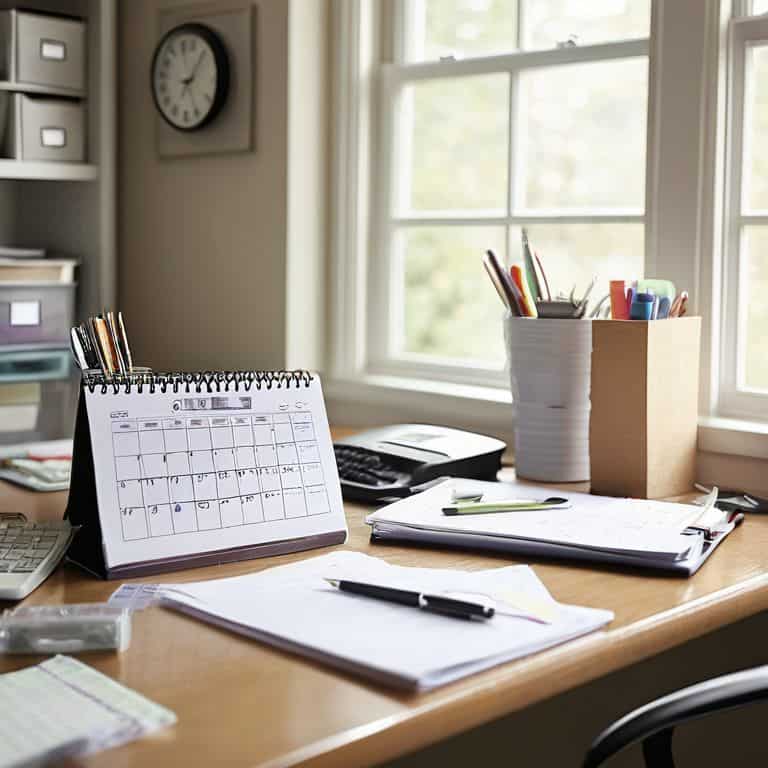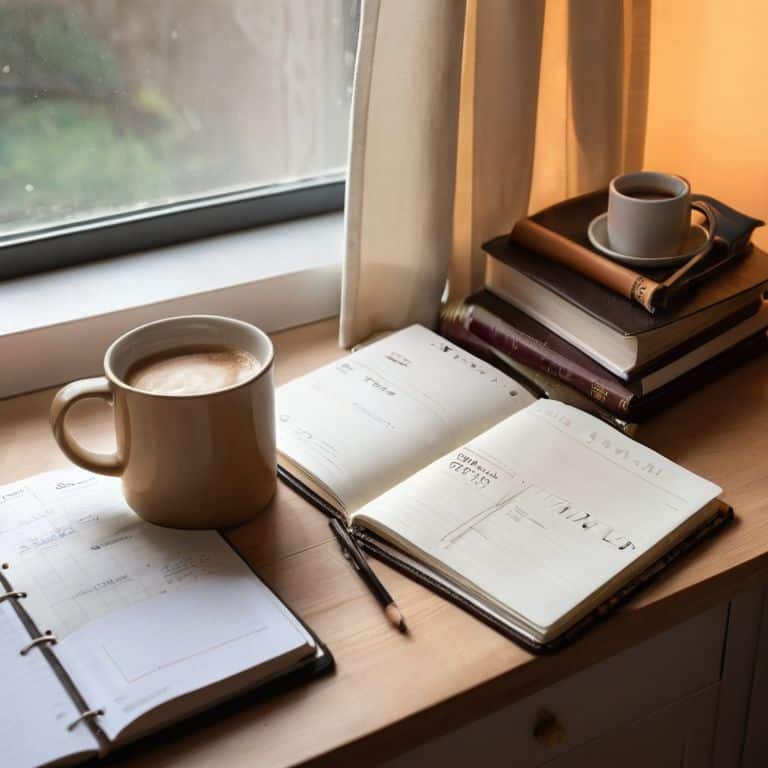I still remember the day I realized that being more organized wasn’t about achieving some sort of mythical perfection, but about creating systems that actually work for me, even on my most chaotic days. I was working for a fast-growing startup, and my desk was a disaster zone – papers everywhere, coffee cups stacked high, and a to-do list that seemed to never end. But as I sat there, feeling overwhelmed and stuck, I had an epiphany: how to be more organized wasn’t about changing who I was, but about changing the way I approached my work and my life.
In this article, I’ll share my no-nonsense approach to getting organized, and provide you with practical, step-by-step advice on how to be more organized. You won’t find any fluffy motivational speeches or generic tips here – just honest, real-world strategies that have worked for me and my clients. I’ll show you how to break down overwhelming tasks into manageable steps, how to create a schedule that actually sticks, and how to tame the chaos that’s holding you back. By the end of this guide, you’ll have the tools and confidence you need to take control of your time, your space, and your life – and start achieving your goals with clarity and purpose.
Table of Contents
Guide Overview: What You'll Need

Total Time: 1 hour 30 minutes
Estimated Cost: $0 – $20
Difficulty Level: Easy
Tools Required
- Planner or Calendar physical or digital
- Pencil or Pen for writing notes and tasks
- Sticky Notes for reminders and to-do lists
Supplies & Materials
- File Folders for organizing paperwork
- Label Maker for labeling folders and storage containers
- Storage Bins for organizing cluttered areas, approximately 12 inches wide
Step-by-Step Instructions
- 1. First, let’s start with a blank slate and acknowledge that becoming more organized is a process that takes time, effort, and patience. It’s essential to understand that it’s not about being perfect; it’s about creating systems that work for you, even on your most chaotic days. Begin by taking a few minutes to reflect on what being more organized means to you and how it will improve your life.
- 2. Next, gather your tools, which include a notebook, a pen, and a willingness to be honest with yourself. Write down all the areas of your life where you feel disorganized, from your closet to your digital files. This list will serve as the foundation for your organizational journey, helping you identify where to focus your efforts.
- 3. Now, let’s break it down into smaller chunks. Take each area you’ve listed and create a separate page or section in your notebook for it. For example, if you’ve listed your closet, your digital files, and your kitchen, you’ll have three separate sections. This will help you tackle one area at a time without feeling overwhelmed by the big picture.
- 4. For each area, create a flowchart or a simple diagram that outlines the current state and your desired outcome. This visual tool will help you understand the workflow and identify any bottlenecks or inefficiencies. Don’t worry too much about making it perfect; the goal is to have a clear, visual representation of your organizational challenges and goals.
- 5. The next step is to set realistic goals for each area. What do you want to achieve in the short term (next week), medium term (next month), and long term (next quarter)? Make sure your goals are specific, measurable, achievable, relevant, and time-bound (SMART). For instance, instead of saying “I want a cleaner closet,” say “I will reduce my closet’s clutter by 50% within the next 3 weeks by dedicating 30 minutes each day to organizing.
- 6. Now, it’s time to develop a maintenance routine for each area. This could be as simple as dedicating 10 minutes each day to tidying up or setting aside one day a week for deeper cleaning and organization. The key is to find a rhythm that works for you and your lifestyle, ensuring that your newly organized spaces remain that way.
- 7. As you progress, track your progress and reflect on what’s working and what isn’t. Use your notebook to jot down notes, successes, and challenges. This reflective practice will help you adjust your strategies as needed and celebrate your achievements, no matter how small they may seem.
- 8. Finally, be kind to yourself throughout this journey. Remember, becoming more organized is a process, and it’s okay to make mistakes or encounter setbacks. Don’t be too hard on yourself if you miss a day or two of your maintenance routine. Instead, learn from the experience and get back on track as soon as possible. Celebrate your small wins, and use them as motivation to keep moving forward.
How to Be More Organized

As you start implementing the steps to create a more organized life, remember that consistency is key. One of the most effective ways to maintain this consistency is by creating a morning routine that sets the tone for the rest of the day. This routine can be as simple as dedicating 10 minutes each morning to planning out your tasks and prioritizing your goals.
In addition to a morning routine, effective task prioritization is crucial for maximizing productivity. This involves not just listing out tasks, but also evaluating which tasks are most critical and tackling them first. Using a planner for productivity can be a powerful tool in this process, helping you stay on track and ensure that you’re making progress towards your goals.
To take your organization to the next level, consider decluttering your digital life. This can involve simplifying your computer files, unsubscribing from unnecessary emails, and streamlining your social media presence. By doing so, you’ll be able to focus more clearly on what’s truly important, and make significant strides in achieving a more balanced and organized life.
Creating a Morning Routine for Success
To kickstart your day with clarity, establish a morning routine that sets you up for success. I recommend starting small: begin with a 10-minute routine and gradually increase the time as you become more comfortable. My own morning routine includes a 10-minute meditation session, followed by a quick review of my schedule and to-do list for the day.
Break down your ideal morning into manageable chunks, such as exercise, journaling, or simply enjoying a cup of coffee in peace. Use a flowchart or a simple list to map out your routine, and don’t be too hard on yourself if you miss a step – the goal is to create a flexible framework that works for you, not against you.
Effective Task Prioritization With Planners
To take your morning routine to the next level, let’s talk about effective task prioritization with planners. I’m a big fan of using physical planners to map out my day, week, and month. There’s something about putting pen to paper that helps me clarify my priorities and stay focused. When using a planner, I recommend starting by brainstorming all the tasks you need to complete, then categorizing them into must-dos, should-dos, and nice-to-dos.
This simple framework helps me avoid overwhelm and ensure I’m tackling the most important tasks first. By breaking down your tasks into manageable chunks and scheduling them in your planner, you’ll be amazed at how much more productive you can be. Remember, the key is to be intentional with your time and energy – don’t be afraid to leave some space for spontaneity and self-care, too.
5 Essential Strategies to Boost Your Organizational Skills
- Start small: Begin with one area or task that feels overwhelming and break it down into manageable chunks, creating a flowchart to visualize your progress
- Schedule ‘white space’: Leave intentional gaps in your calendar for relaxation, self-care, or spontaneity, allowing you to recharge and maintain productivity
- Implement a ‘one touch’ rule: Handle each piece of paper, email, or task only once, taking immediate action or delegating it to a designated list or folder
- Create a ‘stop doing’ list: Identify tasks, habits, or commitments that drain your energy or distract you from your goals, and eliminate them to make space for what truly matters
- Review and adjust regularly: Set aside time each week to review your systems, routines, and goals, making adjustments as needed to ensure you’re on track and maintaining momentum
Key Takeaways for a More Organized You
By creating a tailored morning routine, you can set yourself up for success and create a ripple effect of productivity throughout your day
Implementing effective task prioritization using planners or digital tools can help you focus on high-impact activities and reduce stress
Remember, becoming more organized is a journey, not a destination – it’s about developing flexible systems that adapt to your unique needs and help you find clarity amidst chaos
Embracing Organization
Organization isn’t about achieving some mythical state of perfection; it’s about crafting a system that bends and flexes with the chaos of real life, helping you find your footing no matter what each day brings.
Sloane Kendrick
Embracing a More Organized You

As we’ve explored in this guide, becoming more organized is a journey that involves creating systems that work for you, not against you. From establishing a morning routine that sets you up for success, to using effective task prioritization with planners, it’s about finding the tools and habits that help you stay on track. It’s also important to remember that organization is not a one-size-fits-all solution; it’s about tailoring your approach to fit your unique needs and lifestyle. By implementing these strategies, you’ll be better equipped to manage your time, reduce stress, and achieve your goals.
So, as you move forward on your path to greater organization, remember that it’s okay to take it one step at a time. Don’t be too hard on yourself if you encounter setbacks along the way – simply acknowledge them and get back on track. With patience, persistence, and the right mindset, you can transform your life and unlock a sense of calm, clarity, and purpose that will serve you well in all areas of your life. Keep in mind, the goal is not to be perfect, but to be progressively better with each passing day.
Frequently Asked Questions
How can I stick to my morning routine on weekends or days off when my schedule is less structured?
To stick to your morning routine on weekends or days off, I recommend creating a ‘flexible framework’ – a simplified version of your weekday routine that still sets a gentle tone for the day. Try to maintain at least one or two consistent habits, like meditation or journaling, to provide a sense of continuity and help you stay on track.
What types of tasks should I prioritize first in my planner to maximize productivity?
To maximize productivity, prioritize tasks that are both urgent and important, like deadlines or critical meetings. I like to call these “red flag” tasks. Use your planner to identify and highlight them, and tackle those first. Then, break down larger tasks into smaller, manageable chunks, and schedule them accordingly. This will help you make the most of your time and energy.
How often should I review and adjust my organizational systems to ensure they remain effective?
I recommend scheduling regular check-ins with yourself, whether it’s weekly, monthly, or quarterly, to review and adjust your systems. Ask yourself: Are my routines still working? Are there new challenges I need to address? Use this time to reflect, make tweaks, and ensure your systems remain tailored to your evolving needs.
